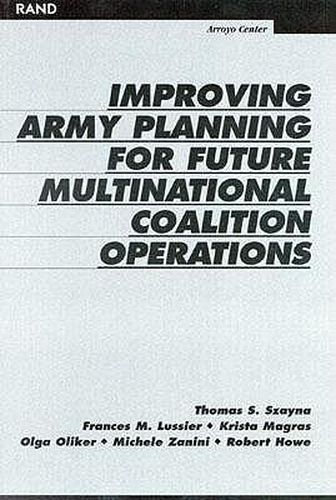Readings Newsletter
Become a Readings Member to make your shopping experience even easier.
Sign in or sign up for free!
You’re not far away from qualifying for FREE standard shipping within Australia
You’ve qualified for FREE standard shipping within Australia
The cart is loading…






The Army currently lacks effective and appropriate processes to plan for enhanced multinational force compatibility (MFC). The current system was not designed for, and therefore is not capable of, supporting centralized oversight of MFC activities. The authors address this problem by focusing recommendations on two primary issues, the management of resources and a means of prioritizing between partners and activities. On the first point, the authors point out the difficulties in identification and control over resources devoted to MFC and stress the need to sensitize the Army Program Evaluation Groups to provide the data required. On the second point, the study outlines a four-step integrated planning system that: (1) identifies the most likely long-term U.S. coalition partners (on the basis of a methodology designed for this purpose); (2) provides a way to pinpoint the compatibility shortcomings of the potential partners across the full range of missions (on the basis of a software program designed for this purpose); (3) links specific Army MFC policies to the shortcomings (on the basis of previous RAND work); (4) once the resource data problems are solved, allows for the determination of cost-effective resource allocation. When cost-effectiveness assessments of MFC efforts become possible, a fifth–currently hypothetical–step of integrating the Army’s own force planning with that of allies and likely partners would become a realistic option. In other words, Army planners could carry out cost-benefit assessments on the basis of tradeoffs between own and ally capabilities, knowing in detail the costs involved, and possibly in cooperation with select allies and partners.
$9.00 standard shipping within Australia
FREE standard shipping within Australia for orders over $100.00
Express & International shipping calculated at checkout
The Army currently lacks effective and appropriate processes to plan for enhanced multinational force compatibility (MFC). The current system was not designed for, and therefore is not capable of, supporting centralized oversight of MFC activities. The authors address this problem by focusing recommendations on two primary issues, the management of resources and a means of prioritizing between partners and activities. On the first point, the authors point out the difficulties in identification and control over resources devoted to MFC and stress the need to sensitize the Army Program Evaluation Groups to provide the data required. On the second point, the study outlines a four-step integrated planning system that: (1) identifies the most likely long-term U.S. coalition partners (on the basis of a methodology designed for this purpose); (2) provides a way to pinpoint the compatibility shortcomings of the potential partners across the full range of missions (on the basis of a software program designed for this purpose); (3) links specific Army MFC policies to the shortcomings (on the basis of previous RAND work); (4) once the resource data problems are solved, allows for the determination of cost-effective resource allocation. When cost-effectiveness assessments of MFC efforts become possible, a fifth–currently hypothetical–step of integrating the Army’s own force planning with that of allies and likely partners would become a realistic option. In other words, Army planners could carry out cost-benefit assessments on the basis of tradeoffs between own and ally capabilities, knowing in detail the costs involved, and possibly in cooperation with select allies and partners.